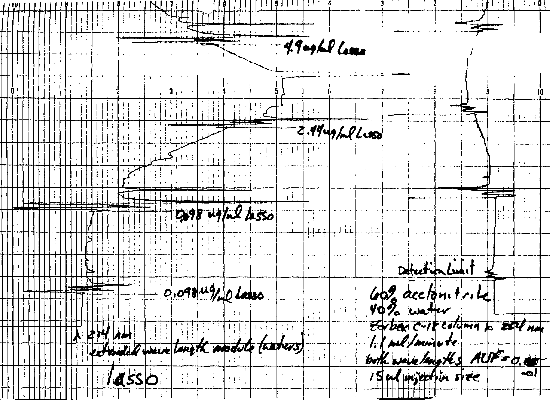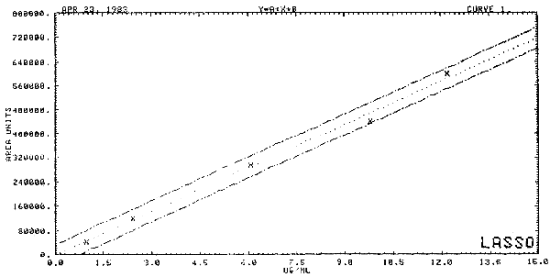LASSO
| Method number: | PV2035 |
| Matrix: | Air |
| Target concentration: | 0.5 mg/m3 |
| There is no OSHA PEL for Lasso. Neither NIOSH nor ACGIH has a recommended standard for Lasso. For the purpose of this study, the target concentration has been arbitrarily set at 0.5 mg/m3. It represents 100X the detection limit for the proposed method. | |
| Procedure: | Collection on a glass fiber filter (GFF) with backup pad (BUP), extraction of both the GFF and BUP separately with acetonitrile, and analysis by high performance liquid chromatography (HPLC) at two wavelengths, 214 nm and 254 nm. |
| Recommended air volume and sampling rate: |
100 L at 1 Lpm. |
| Detection limit of the overall procedure based on the recommended air volume: | 0.005 mg/m3 |
| Status of method: | This method has been only partially evaluated and is presented for information and trial use. |
| Date: 1-13-84 | Chemist: John Linkletter |
Carcinogen/Pesticide Branch
OSHA Analytical
Laboratory
Salt Lake City, Utah
1. General Discussion
- 1.1. Background
- 1.1.1. History of procedure
Recently the OSHA Analytical Laboratory received a set of field
samples requesting analysis for Lasso. The air samples had been
collected on glass fiber filters. This report describes the
analytical procedure developed and the preliminary validations of
the sampling method. Lasso (Alachlor) is a
1.1.2. Toxic effects
(This section is for information only and should not be taken as the basis of OSHA policy)
Possible genetic damage by the herbicide, Lasso was indicated by a paper. (Ref. 5.2.)
1.1.3. Potential workplace exposure
Lasso (Alachlor) is used in the
1.1.4. Physical properties
| CAS Reg. Number: | 15972-60-8 |
| Chem. Abstr. Names: | Acetamide, |
| Appearance: | Cream-colored solid |
| Molecular weight: | 270 |
| Melting point: | 39.5 - 41.5°C |
| Vapor pressure: | 0.02 mm Hg (100°C) |
| Solubility: | soluble in ether, acetone, benzene, ethanol and ethyl acetate |
| Molecular formula: | C14-H20-Cl-N-O2 |
1.2. Limit defining parameters
1.2.1. Detection limit of the analytical procedure
The detection limit of the analytical procedure is 1.5 ng Lasso per injection. This is the amount of analyte which will give a peak whose height is approximately five times the amplitude of the baseline noise. See figure 1.
1.2.2. Detection limit of the overall procedure
The detection limit of the overall procedure is estimated to be 0.5 ug per sample or 0.005 mg/m3 based on the recommended air volume, assuming 100% recovery from the sampling device. The recovery test at this level has not been performed.
1.2.3. Sensitivity
The sensitivity of the analytical procedure over a concentration range of 0.98 to 12.2 ug/mL is 47,890 area units per ug/mL of Lasso. The sensitivity is determined by the slope of the calibration curve. See figure 2.
1.3. Advantages
The analytical procedure is rapid, sensitive, and reproducible.
1.4. Disdvantages
- 1.4.1. The method has not been fully validated.
1.4.2. Both the glass fiber filter and the backup pad must be analyzed for Lasso separately.
2. Sampling Procedure
- 2.1. Apparatus
- 2.1.1. An air sampling pump with a flow rate which can be
calibrated to within ±5% of the recommended 1 Lpm flow rate while
the sampler is in line.
2.1.2. Glass fiber filter,
2.1.3. Backup pad,
2.1.4. Filter holder for
2.2. Sampling technique
2.2.1. Assemble the filter in the
2.2.2. Attach the outlet of the filter cassette to the personal sampling pump inlet with flexible tubing.
2.2.3. Air being sampled should not pass through any hose or tubing before entering the filter cassette.
2.2.4. A sample size of 100 liters is recommended. Sample at a flow rate of 1.0 liters/minute. The flow rate should be known with an accuracy of ±5%.
2.2.5. With each batch of samples, submit a blank filter from the same lot of filters used for the sample collection. This filter must be subjected to exactly the same handling as the samples except that no air is drawn through it. Label this filter as a blank.
2.2.6. The cassette should be shipped in a suitable container designed to prevent damage in transit. The samples should be shipped to the laboratory as soon as possible.
2.2.7. A sample of the bulk material should be submitted to the laboratory in a glass container with a Polyseal cap. Never transport, mail, or ship the bulk sample in the same container as the sample or blank filter.
2.3. Retention efficiency
Three glass fiber filters were spiked with 49 ug of Lasso. Humid air (85% relative humidity) 100 liters was drawn through the filters at Lpm. The recovery of the filter plus the backup pad was 93%.
| Total | ||||
| Sample | Spiked Amount | Treatment | Peak Area | Recovery |
| L-GFF100L-1 | 49 ug on GFF | 100 L humid air | 325,205 | |
| L-BUP100L-1 | not spiked | 100 L " " | 78,049 | 91% |
| L-GFF100L-2 | 49 ug on GFF | 100 L " " | 377,738 | |
| L-BUP100L-2 | not spiked | 100 L " " | 41,098 | 94% |
| L-GFF100L-3 | 49 ug on GFF | 100 L " " | 326,168 | |
| L-BUP100L-3 | not spiked | 100 L " " | 88,949 | 94% |
| Lasso std. | ||||
| 9.8 ug/mL | 49 ug; control | None | 444,156 | - - - |
| Lasso std. | ||||
| 9.8 ug/mL | 49 ug; control | None | 442,351 | - - - |
2.4. Extraction efficiency glass fiber filter
The average extraction efficiency from the glass fiber fibers spiked with 49 ug of Lasso was 91%.
| Sample | Spiked Amount | Peak Area | Recovery |
| Ex GFF-1 | 49 ug on GFF | 404,492 | 91% |
| Ex GFF-2 | 49 ug on GFF | 404,168 | 91% |
| Ex GFF-3 | 49 ug on GFF | 410,590 | 92% |
| Lasso std. | |||
| 9.8 ug/mL | 49 ug; control | 444,791 | - - - |
| Lasso std. | |||
| 9.8 ug/mL | 49 ug; control | 444,156 | - - - |
2.5. Extraction efficiency backup pad
The average extraction efficiency from the backup pad spiked with 49 ug of Lasso was 102%.
| Sample | Spiked Amount | Peak Area | Recovery |
| Ex BUP-1 | 49 ug on BUP | 370,752 | 103% |
| Ex BUP-2 | 49 ug on BUP | 370,445 | 103% |
| Ex BUP-3 | 49 ug on BUP | 364,837 | 103% |
| Lasso std. | |||
| 9.8 ug/mL | 49 ug; control | 360,045 | - - - |
| Lasso std. | |||
| 9.8 ug/mL | 49 ug; control | 362,759 | - - - |
2.6. Storage
Storage test was not done.
2.7. Recommended Air Volume and Sampling Rate
2.7.1. The recommended air volume is 100 liters.
2.7.2. The recommended sampling rate is 1 Lpm.
2.8. Interferences
There are no known interferences associated with the sampling procedure.
2.9. Safety Precautions
2.9.1. Attach the sampling equipment to the worker in such a manner that it will not interfere with work performance or safety.
2.9.2. Follow all safety practices that apply to the work area being sampled.
3. Analytical Method
- 3.1. Apparatus
- 3.1.1. High performance liquid chromatograph equipped with pump
sample injector, extended wavelength module, dual wavelength
detector, chart recorder, and other necessary hardware.
3.1.2. HPLC reverse phase
3.1.3. An electronic integrator or other suitable method to measure detector response.
3.1.4. Microliter syringe or automatic sampling device for making sample injections.
3.1.5. Volumetric flasks of convenient sizes for preparing standards.
3.1.6. Shaking device for extraction of samples.
3.2. Reagents
3.2.1. Lasso (EPA standard 8452)
3.2.2. Acetonitrile, HPLC grade
3.2.3. Water, HPLC grade
3.3. Sample Preparation
3.3.1. Remove the filter from the cassette with clean tweezers and place it in a 20-mL scintillation vial.
3.3.2. Add 5 mL acetonitrile to the vial and cap it.
3.3.3. Shake the vials vigorously on a shaker for 30 minutes.
3.4. Standard Preparation
3.4.1. Standard of Ramrod is prepared by dissolving 9 to 12 mg (accurately weighed) of Lasso in acetonitrile in a 10 mL volumetric flask and making it to volume.
3.4.2. Dilute to the working range of 0.9 to 12 ug/mL with acetonitrile.
3.4.3. Store standards in dark bottles under refrigeration.
3.5. Analysis
3.5.1. HPLC Conditions
| Column: | Zorbax ODS (25 cm x 4.6 mm) |
| Mobile Phase: | 60% acetonitrile, 40% water |
| Flow Rate: | 1.1 mL/minute |
| Dual Wavelength Detector: | 214 nm, 254 nm |
| Injection Volume: | 15 uL |
| Retention Time: | 12.4 minutes |
3.5.2. Chromatogram
See Figure 1.
3.5.3. Peak magnitude is measured by electronic integrator or other means.
3.5.4. An external standard procedure is used to prepare a calibration curve from the analysis of at least three different concentrations from two separate weighings.
3.5.5. Bracket the sample with analytical standards.
3.6. Interferences (analytical)
3.6.1. Any collected compound that has the same LC retention time as analyte and absorbs at 214 nm and 254 nm is an interference.
3.6.2. HPLC parameters may be varied to circumvent most interferences.
3.6.3. Retention time alone is not proof of a chemical identity. Confirmation by other means should be sought when possible.
3.7. Calculations
3.7.1. The integrator value in area units for each standard is plotted against its concentration in ug/mL and a calibration curve using the best fit straight line through the points is obtained.
3.7.2. Sample concentration is calculated from the calibration curve.
3.7.3. The air concentration of Lasso for a sample is calculated by the following equation:
| mg/m3 = | (µg/mL in sample)(extraction
volume, mL)
(air volume, L) |
3.8. Safety Precautions
3.8.1. Confine the use of solvents to a fume hood.
3.8.2. Wear safety glasses in all laboratory areas.
4. Recommendations for Further Study
- 4.1. Storage test
- 4.1.1. Do a complete storage test.

FIGURE 1. DETECTION LIMIT

FIGURE 2. CALIBRATION CURVE
5. References
- 5.1. Amann, B.D.; Call, D.J.; Draayer, H.H.; J. Assoc. Off.
Anal. Chem. 59(4), pp.
5.2. Njagi, G.DE; Gopalan, H.NB.; Cytologia 46(1-2) pp.
5.3. Ovellette, R.P. Chemical Week Pesticides Register. 1977, pp. 265.